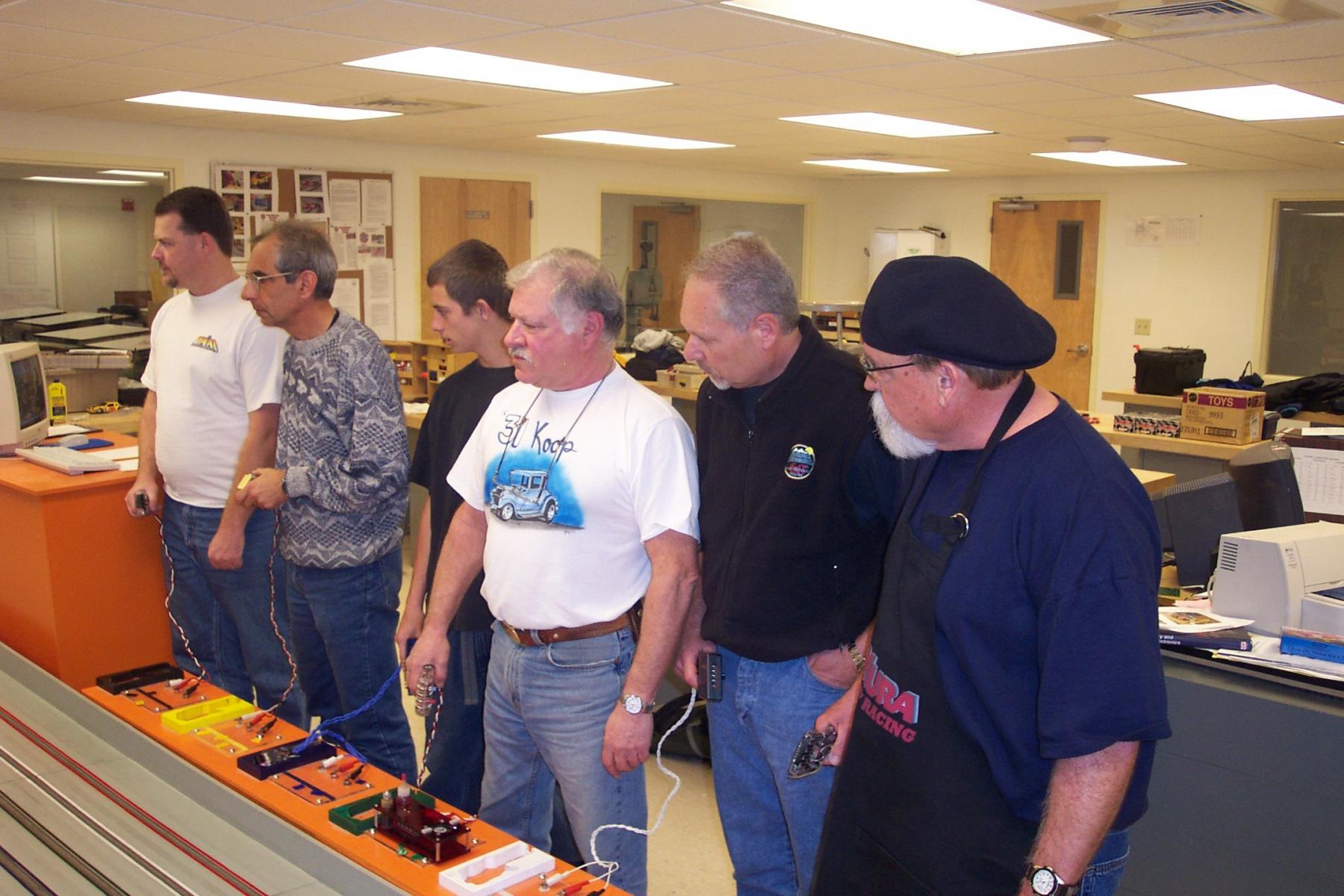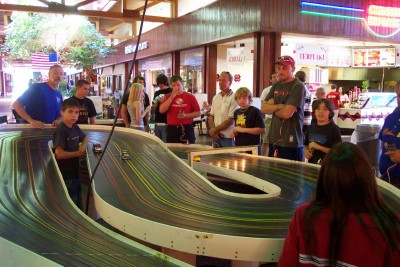Over the last few decades, I have been webmaster and curator of several slot-car related sites and have posted in several forums on a regular basis. As such, I have accumulated thousands of images and slot-car related material. While assembling a nostalgia piece, I came across scores of images associated with a High School slot-car club that I organized more than twenty years ago. These brought back some fond memories and some hard lessons that I thought I would share with the slot-car community. The project was a modest success and the club endured for several years. At the end of the post, I listed what might have been done for a better outcome.
It was the early 2000s and I was enjoying semi-retirement. At that time, we were spending most of our time in our Prescott, Arizona condo. I remembered reading about Wayne Halabourda, a high school technology teacher, who built a six-lane track at his school and formed a school club back in 1998. The first track that Wayne built had a footprint of 10x18 with 65 running feet per lane. He combined the track experience with lesson plans. The first year, he had 16 participants. The next year participation had grown to a whopping 94. With so many new faces, he needed a larger track. The second track he built was CNC routed eight-lane track with a footprint 13x28 and 105 running feet per lane. Both tracks are shown below.
I thought, Why not build a track at a Prescott school and start a club for students and adults? My wife thought it wasnt a good idea. She said, Kids are interested in video games, not models of little cars. Now that was a challenge. I told her that I would get a minimum of 30 students in the club as well as several of my adult friends. So, as a type A, I proceeded to formulate a business plan. Below is an outline of that plan.
- Develop and formalize sales pitch for school slot racing program
- Canvass schools in the Prescott, Arizona that met the following conditions
o Adequate space for the track
o Well-equipped wood shop
- Secure Funding
- Solicit students for club membership
- Solicit Adult Members to supervise and mentor Club members
- Elect Club Officers
- Design and Build Track
- Acquire Timing and Scoring system
- Acquire Computer and monitor
- Acquire Club Cars
- Create advertising material
- Participate in School Club Day
Involve Art Class
- Design Logo
- Create murals for the club room
- Airbrush models
- Create Custom Decal sets
- Mold and Cast custom bodies
- Build Slot Car boxes
- Build scenery
- Create Accounting System
- Create Inventory System
- Set-up a Store to sell inventory (cars, controllers, parts, painted bodies, slot car boxes etc.)
- Staff the Club room/Store
- Develop Database with easy to use interface to log race results
- Integrate Database with existing timing and scoring system
After canvassing several schools, I settled on Prescott High. The Technology teacher seemed interested and could set aside room for the track. The next order of business was to secure funding for the project. This turned out to be a relatively simple task. Funding came from several sources including the following.
- Home Depot supplied all of the wood and fasteners.
- Ruddick supplied the club with six controllers.
- SRT provided the timing and scoring system.
- York Dodge, Chrysler, Jeep donated several hundred dollars
- Several parents of club members donated funds (note that in Oregon a taxpayer could make a donation of up to $250 to a non-profit or school and get a state tax credit, so it really cost the parents nothing).
- School Technology Budget provided some funds.
I came up with a track design to fit the allowable space leaving some room for marshals. The track footprint was approximately 23X14 feet (see image below for track schematic and finished product.
Next it was time to begin the building process and recruit a core of student members to assist in the build. I had also hoped that these core members would be great promotors of the club and bring in a cadre of new members.
Prescott High School had a large and well equipped wood shop. Track sections were fabricated using .5 inch MDF, track walls were fabricated from hardboard and legs were fabricated with plywood. Traditional commercial braid was utilized to conduct electricity. With the help of the Technology teacher and a few club members, we completed the track in a few months working part time in the evening and on some weekends. See images below for various stages of the build.
The track was completed in the early spring of 2002. The 2001/2002 school year was PASAs inaugural year. Without a finished track until the spring of 2002, it was somewhat of a struggle recruiting members. I was sure that this would change after we had the track up and running. By the end of the school year in June of 2002, we had ten students and six adults actively participating in the club. I was a bit disappointed but looking forward to the upcoming full year of operation. However, despite our best efforts creating fliers, newsletters, and word of mouth, the club grew slowly in the next few years to about 15 students and 8 adults. I had hoped for much more. The focus of our efforts would remain squarely on building club membership and any thoughts about Phase 2 of the project were put on hold.
In the inaugural year we raced rattle chassis Econo cars purchased from a scratch builder in Oregon. Prior to the institution of the club, I had purchased several of these for personal use. At that time, the finished chassis cost $70. The only additional expense was the plastic model body and spray paint. Even though reasonable, there was a lot of push back regarding cost. In subsequent seasons we opted for the old ProTrack brass chassis which at the time cost only $29, obviously a much less expensive option.
Below are images of the racing experience from 2002 through 2004.
My wife and I moved to Roseburg, Oregon in 2005. The late Al Weiss took over the club as the premier non-faculty advisor, a role that I held from the very beginning. Al was a hard core modeler and fan of model car racing. He kept the club going for several more years until the Technology teacher retired. The new Tech teacher had no interest in slot cars, disbanded the club and stored the track in the auto shop. I am not sure where it went after that.
In the end, the club was a modest success in terms of numbers. We averaged about 12-15 student members and about 6 adults. That being said, there were a few young men that were really helped by participation. I recall one young man that had very little self-confidence and was quite withdrawn. He took to the hobby, learned as much as he could and then became a mentor to new members. His metamorphosis was amazing and helping just that one boy made the whole project worthwhile.
What could I have done to make the project more successful and sustainable with a healthy membership of 30 or more students and 10 or more adults? I have given that question a lot of thought over the years. Below are some of my ideas in bullet point form
- Have the full commitment of the school sponsor
- Do not agree to embark on the project unless the club room is available at least two evenings per week and on each Saturday afternoon
- Secure adequate funding before launching into the project
- Keep the cost of racing down using economical chassis and bodies
- Appeal to a wider audience. When kids get to be 16 they focus on real cars and girls. Perhaps a joint project between a middle and high school would attract and retain more members






















































